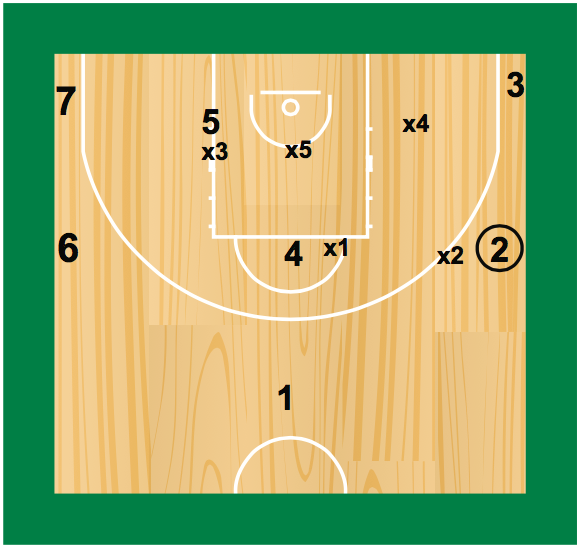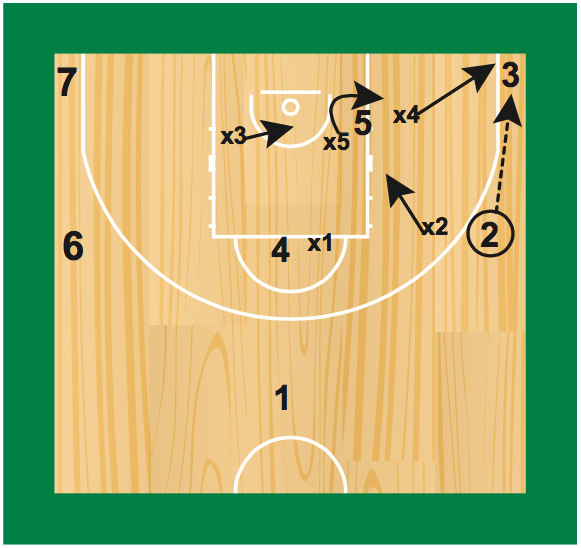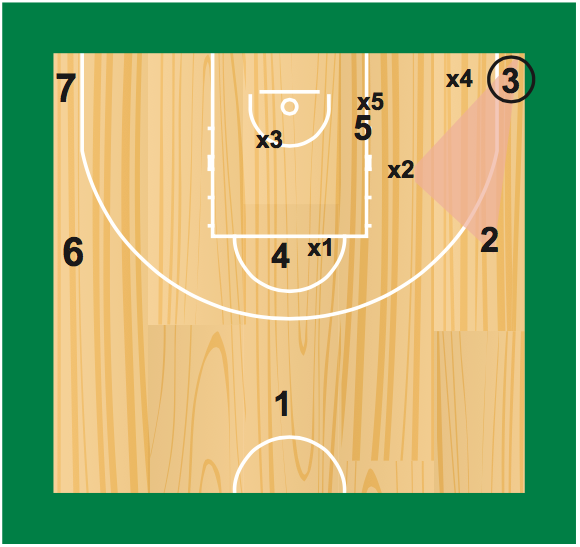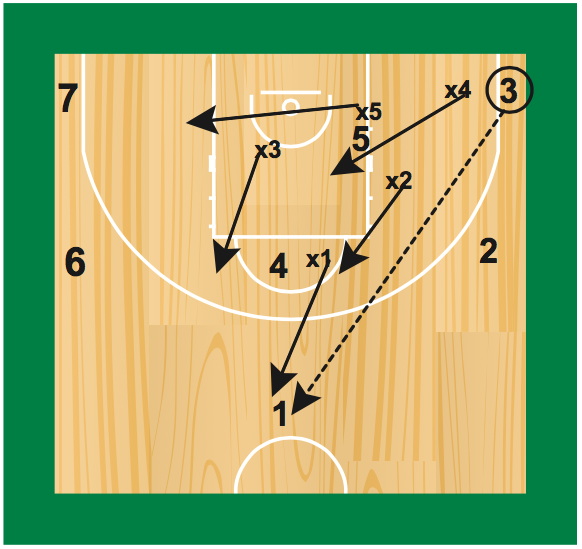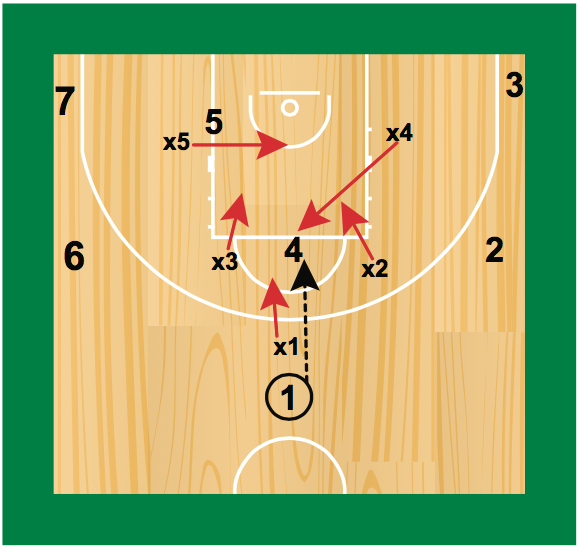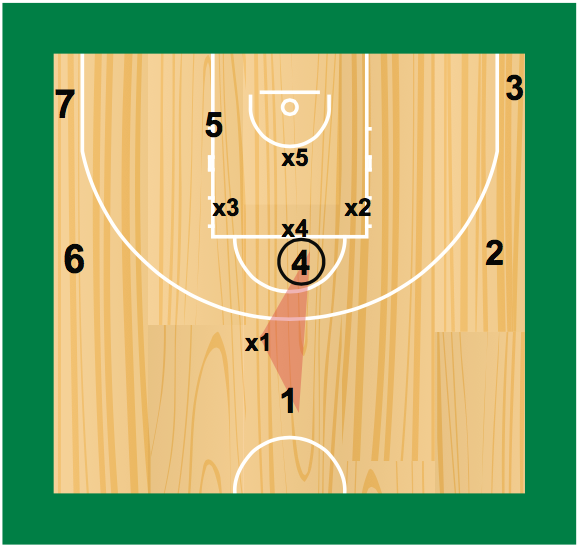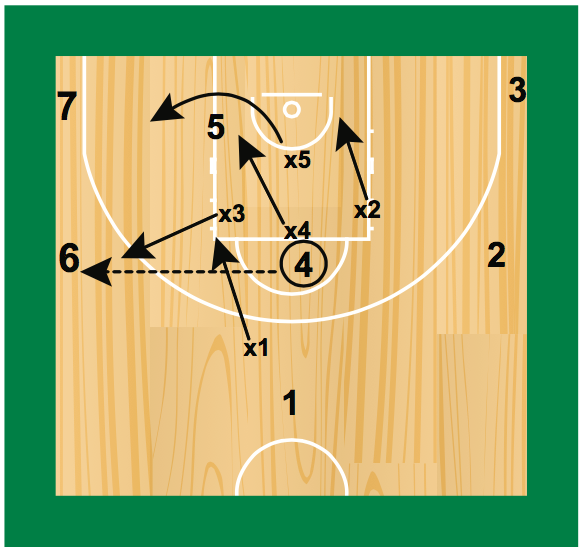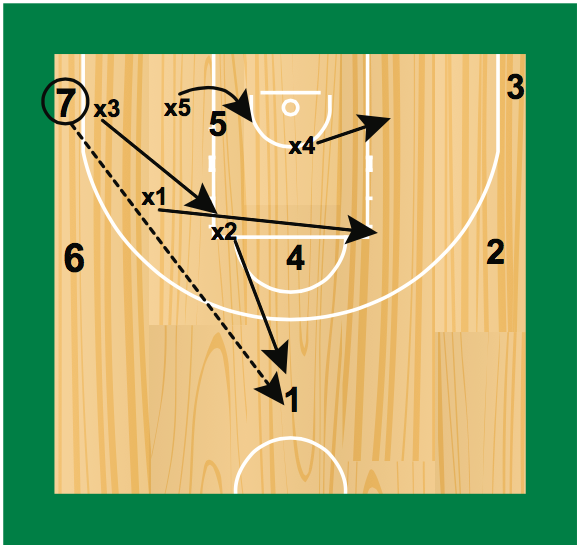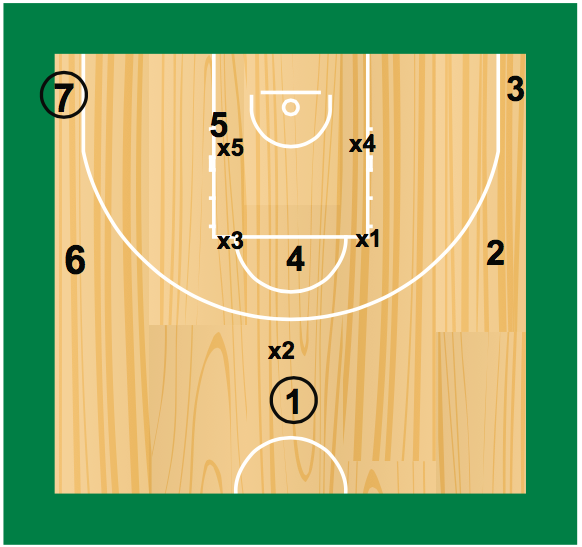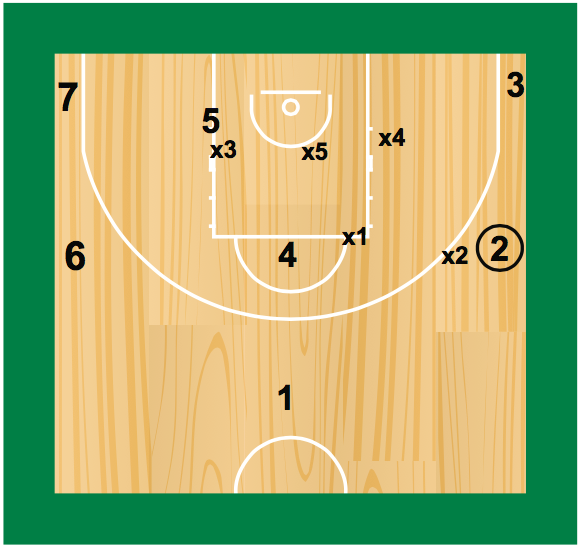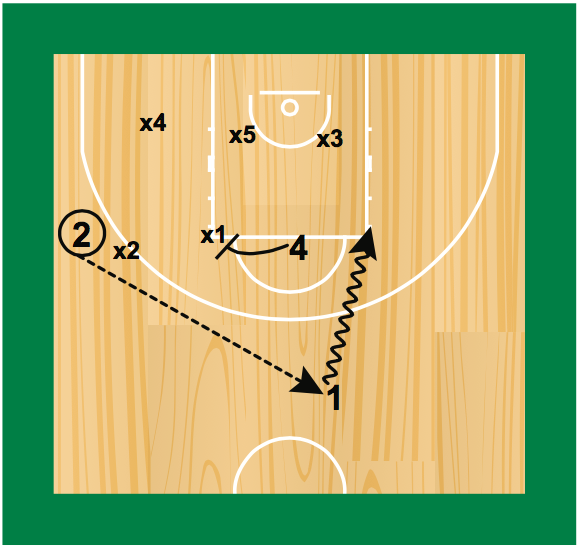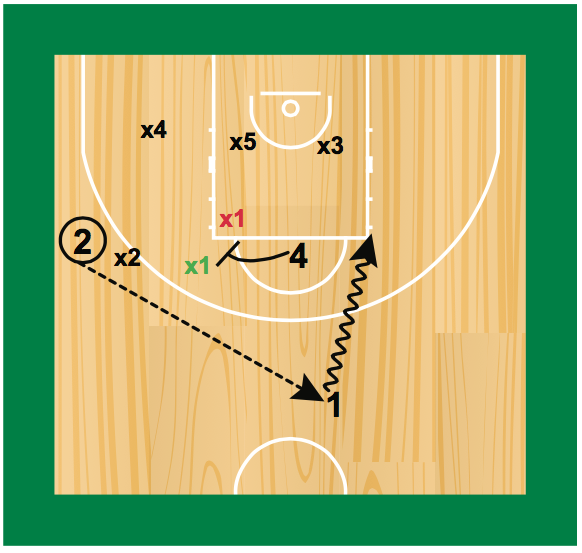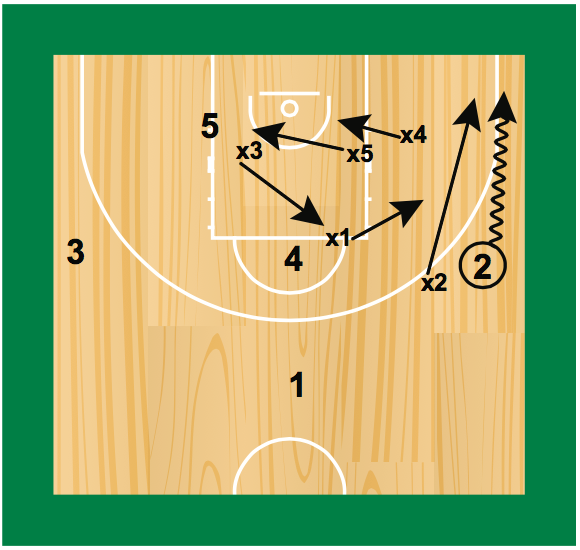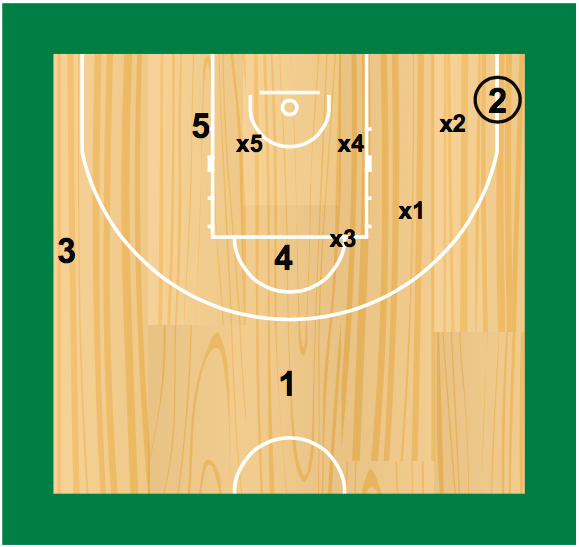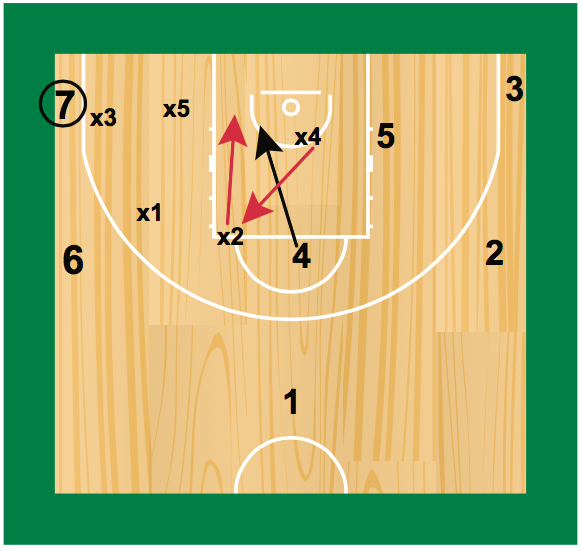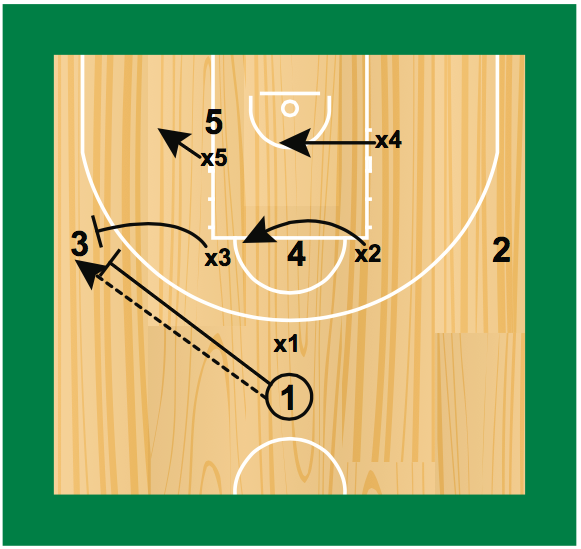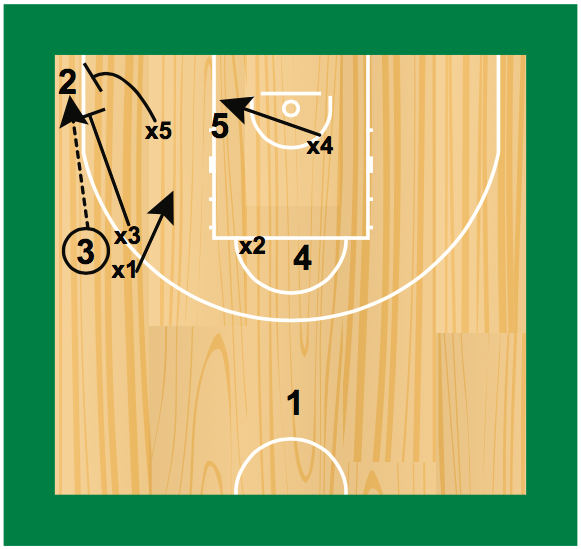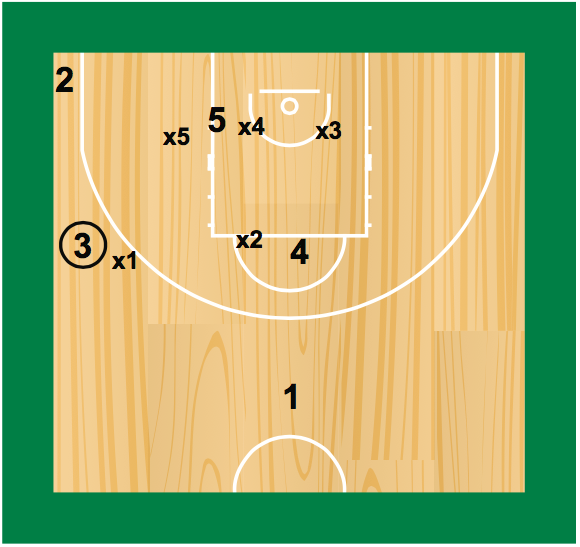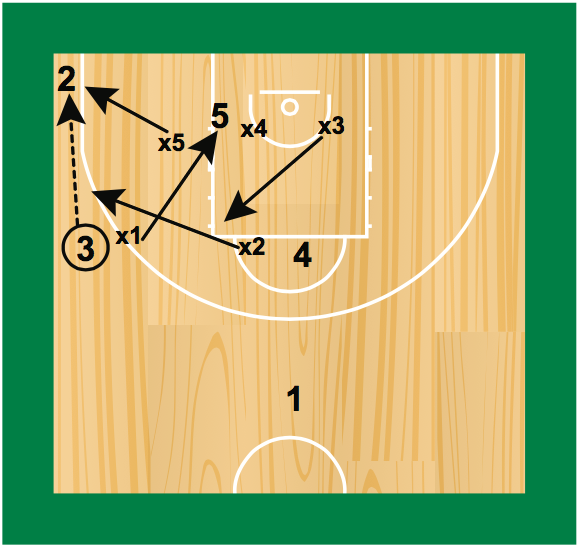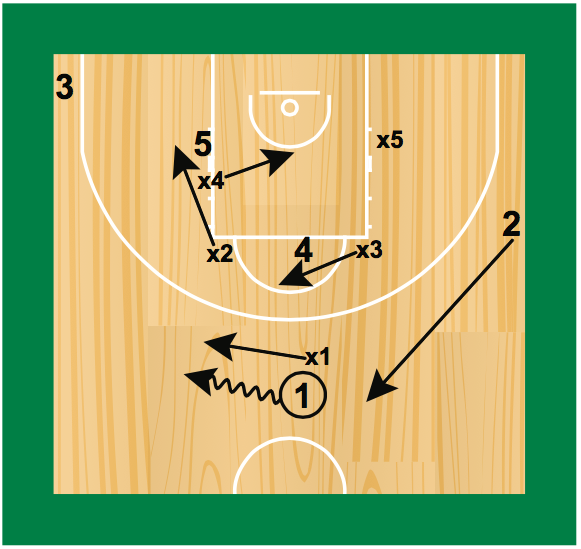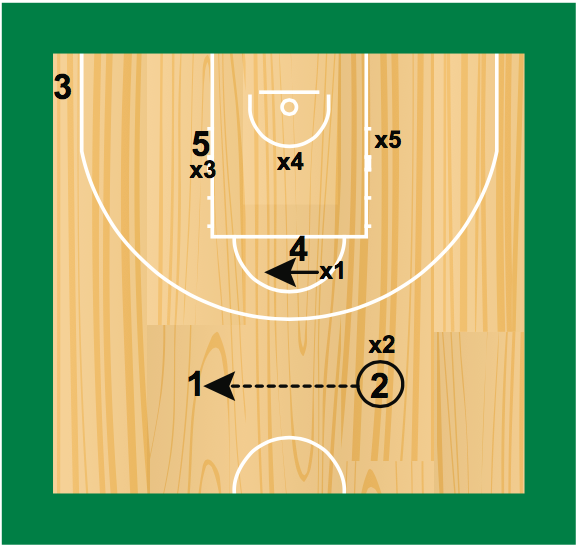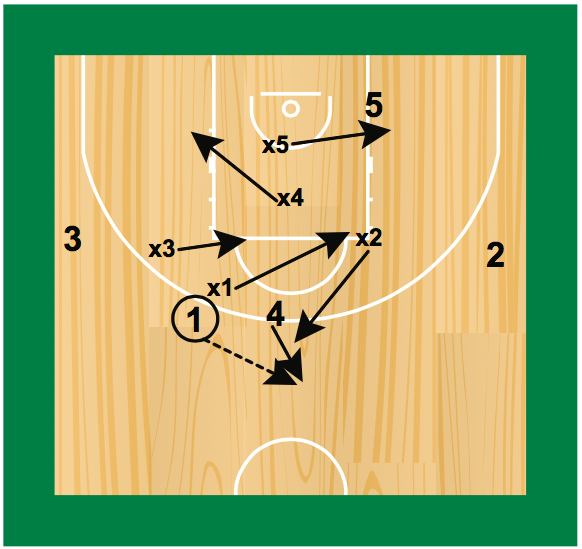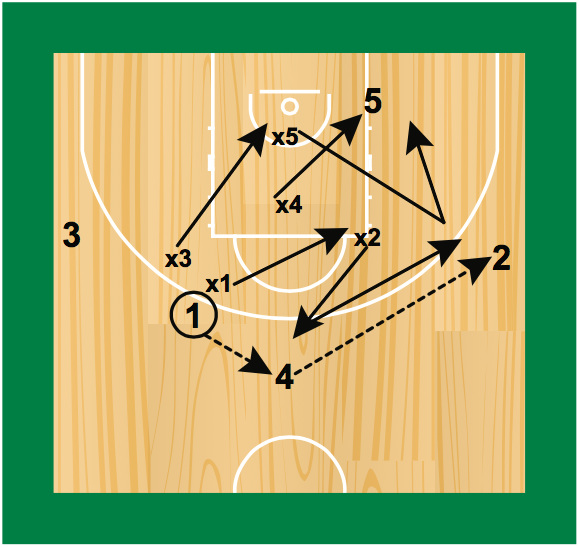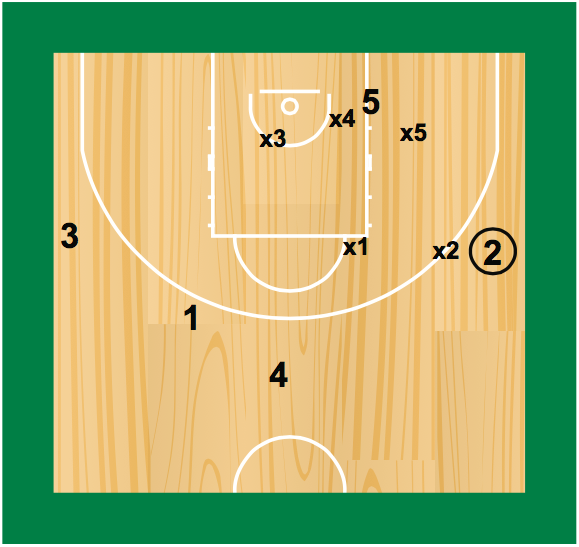Level 3
1.3.1 1-2-2 Match up defence
One advantage of a match up zone defence is that it may confuse opponents about what defence your team is playing. This can be particularly effective against opponents that have one offence to play against zone defence and a separate offence to play against man to man.
There are various alignments that can be used in zones and most have options for trapping and “denial” pressure if you want to utilize them. In determining which zone defence to use you should consider:
- Your physical talent: some zones will allow you to keep “bigs” near the basket, others have a lot of interaction between perimeter and post players;
- Your opponent’s shooting: some zones provide better coverage of perimeter shooters than others (e.g. a 1-3-1 provides better coverage than a 1-1-3);
- Your preparation time: the more your zone defence has rules that are consistent with your “man to man” defence, the less time it will take to teach it.
All match up zones require good “man to man” defensive skills, particularly:
- Ability to contain the ball and influence where it is dribbled or passed;
- Keeping vision of both the ball and players on the “weak side”;
- “Flying with the ball”: defenders moving to their next position while the ball is in the air, so that they arrive as the ball is caught.
1-2-2 Match Up defence
The 1-2-2 match up defence can be demonstrated, and practiced, against 7 players.
Initial Alignment and Slides
Using seven offensive players (5 perimeter, high and low posts) will show all the coverage that is required.
Defenders start:
- x1 takes the ball;
- x2 and x3 occupy the high post area – keeping arms in front of the post player to stop any pass;
- x4 and x5 are in the low post areas.
On a pass to the wing:
- the closest guard (x2) takes the ball
- x1 drops back to guard the high post
- the closest forward (x4) steps out •the other forward steps across
- the other guard rotates down into the front line
x4 is in position to guard the perimeter player in the corner if they are passed the ball. They keep their hands active to discourage any pass into the low post area behind them.
As the ball is passed out of the corner, defenders rotate their position. If the ball was passed to the wing, x2 would take it.
If the ball is passed back to the point, defenders rotate back to the 1-2-2 alignment. x1 may “hold” at the free throw line to deny a pass to 4, staying there until x2 or x3 recover. x4 should have their hands in front of 5 to stop a pass to the low post.
Defending High Post
If the ball is passed to the high post player (4), either x4 or x5 steps up to defend them, the other forward rotates toward the middle of the key. Which defender moves to defend the high post player can be determined by:
- whoever is closest;
- where there is also a low post, as the defender on the other side of the key steps to defend the high post;
- a team rule that one defender will always be the high post defender; or
- whichever side the high post player prefers to drive, the defender from that side then moves to defend them (and is in a better position to stop any dribble).
The two wing players (x3 and x2) drop below the high post player and, in particular, help deny any pass to a low post player.
x1 also drops to pressure the high post.
Importantly, if the ball is passed to the corner, this is taken by a guard (x3). Other players rotate so that they end up with:
- 3 players on the front line (x3, x5 and x4) – guarding the ball, low post and help position;
- 1 guard at the high post (x2);
- 1 guard at the wing, close enough to the low post to help deny any pass.
“Scrambling” Rotations
The rotations on a pass from the corner return defenders to the initial alignment. However, if the ball is quickly passed to the opposite wing, the slides may need to be different:
- x4 is closest to 2 so initially closes out to guard the ball. However, a “rule” of the defence is that x4 and x5 do not guard on the wing;
- x2 moves to the wing as quickly as possible, allowing x4 to return to a frontline position;
- x1 moves to guard the high post, and x3 remains on the front line.
Avoiding Screens
A common tactic used against zone defences is to set screens on the “outside”. Accordingly, defenders need to adjust their position to ensure that a post defender cannot set an effective screen.
Here. 4 can screen x1, providing 1 with a lane to penetrate into the keyway. x1 needs to adjust their position so that they can move past the high post player.
When the screen is set, the defender should adjust their position, so that they can move past the screen. They can move below (shown in green) or above (shown red) the screener.
Moving below the screen may be preferred as it gives a better angle to stop penetration by 1. However, if 1 is a very good perimeter shooter, x1 should move 4’s screen. If they move below it, they may be re-screened by 4 and not be able to defend a shot.
Defending Dribble
x1 should attempt to influence the ball to one side of the court or the other. Which side will depend upon the “scout” and whatever tendencies the opponent has. If they usually play from the right hand side, force them left!
As the ball is dribbled to the wing, x1 “hands off” the dribbler to x2, who guards them to the wing. Other players rotate the same as if the ball was passed to the wing.
Again, the resulting alignment is similar to when a ball is passed to the corner.
If the corner player dribbles out to the wing:
- if a guard is defending (e.g. x2) – they remain on the player to the wing;
- if a forward is defending – the “hand off” to the nearest guard and then rotate back onto the front line.
Defending Post Cut
If the high post player dives to the basket, the guard must also defend that cut. This can be done by switching with the help side defender (as shown) although this is most effective when the help side defender is a guard.
It can also be done by “handing” off the cutter to one of the front line defenders, which is particularly effective if they post up.
Trapping
The zone can trap at either the wing or the corner. The wing trap is set:
- x3 moves to the wing as the ball is passed and x1 follows the pass (this works best when x1 is closer to the wing than the middle of the court);
- x2 moves to cover deny the high post
- x5 moves to short corner and x4 rotates to low post.
To trap in the corner, the guard from the wing follows the pass. This can be done after trapping at the wing or just in the corner.
A forward then defends the low post and guards defend both the high post and the wing.
The difference here from normal coverage is that the “help defender” is not present
On a pass to the corner:
- x5 rotates to defend the ball;
- x3 rotates to deny the high post.
- x4 remains behind the post player to stop any lob pass;
- x2 rotates to deny a pass back to the wing;
- x1 rotates to deny a pass to the high post.
Adjusting to a “2 Guard Front”
Commonly an offensive team that is facing a zone defence that has a guard in the middle of the floor will place two offensive players at the top of the key.
In the 1-2-2 match up, the guard that has the ball (x1) moves with it and the other guard (x3) moves to the middle of the foul line and in front of any high post. x2 rotates to the front line.
x2 makes this rotation as x3 has further to move to reach the position.
Once the ball is reversed, the guard from the high post defends the ball, and the other guard rotates back to the high post.
Similarly, if the ball is passed to the wing, the guard at the high post moves to defend the wing. To help this, the guard may stand to the ball side of the high post player, whilst keeping hands in front of the player to deny a pass.
As the ball is passed to the wing, the forward may hedge toward the wing before recovering back to the front line. This can give the guard time to get to the wing.
Often the screener, will quickly pass to the wing – this “second pass” is often the most effective at creating an open shot.
This is a “scramble” situation. The forward may need to guard the wing, and then be “bumped down” by a guard, to return to the normal alignment. This is shown in the movement of x5 and x2.
Good communication is the key to this working. The aim is to make the most “efficient” slides and if all team mates know what the others are doing, the defence can be effective.
Here the team rule can be “it’s only wrong, if you don’t bring your team mates along!”
Defending 2 High Posts
Where an offence has two high post players, both guards at the high post deny an offensive player. Again, they do not have to stand directly in front of the post player, but must deny the pass by at least having an arm across the post player.
If the ball is passed to one of the post players, both guards drop and the forward steps up to guard the post player while the other forward moves to the middle of the key.
The defence has now moved to the same alignment as when a single high post receives the ball. The guards (x3 and x2) will move to defend any wing or corner player that receives a pass from the high post.
When to use the 1-2-2?
The main characteristics of this defence are:
- x4 and x5 do not have responsibility to guard wing players;
- x2 and x3 will have responsibility to defend in the “front line”, at times which may involve guarding post players
Accordingly, the defence may suit teams that have “bigs” that are slow guarding perimeter players or have “swing players” that can guard both perimeter and post.

